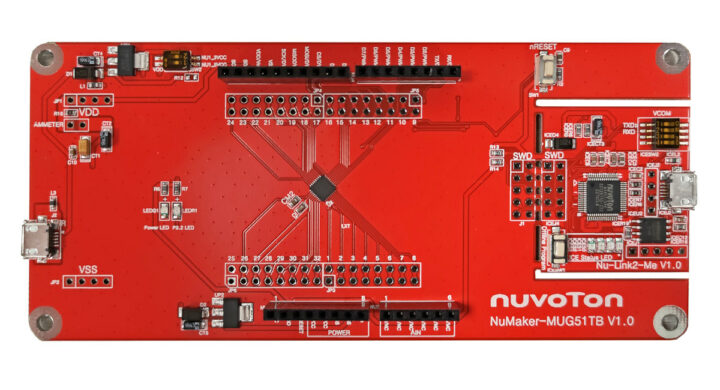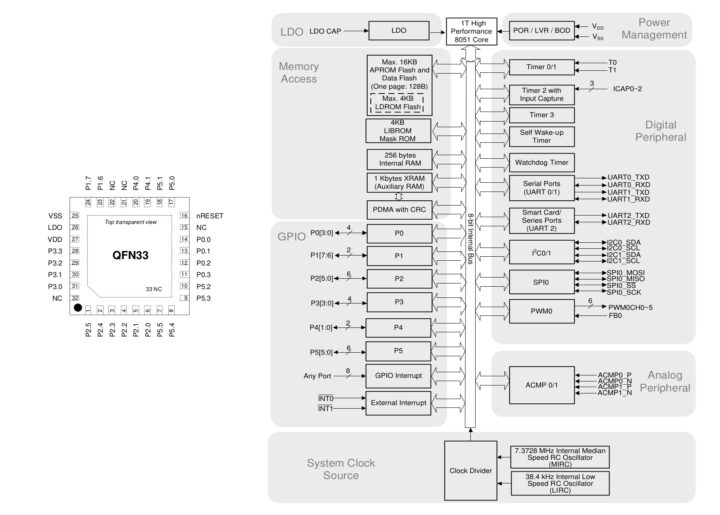8-bit microcontrollers are here to stay despite the rise of 32-bit microcontrollers. Renesas introduced the RL78/G15 entry-level 8-bit microcontroller in a tiny 3x3mm package at the beginning of the year, and now Nuvoton has just unveiled the MUG51 8-bit 8051 microcontroller with a long-term production commitment.
The MUG51 is specially designed for battery-free devices such as passive stylus pens and RFID cards. The 8-bit microcontroller embeds 1 KB SRAM, 16KB flash plus 4KB flash for user program loader, various peripherals with up to 24x GPIOs with interrupt, I2C, SPI, UART, DMA, and so on, as well as various timers.

Nuvoton MUG51 specifications:
- Core – 1T 8051-based core running up to 7.3728 MHz
- Memory/Storage
- 1 KB SRAM
- 16 KB Flash
- Up to 4 KB Flash for user program loader (LDROM)
- 128 bytes SPROM (Security Protection ROM)
- ISP/ICP/IAP programming
- Peripherals
- Up to 24x I/O with interrupt capability
- 2x UART (Tx/RX), 2x I2C, 1x SPI, 1x ISO 7816-3 interface supporting full-duplex UART mode
- Up to 2 channels PDMA
- 2x rail-to-rail comparators (ACMP)
- Timers
- 4x 16-bit timers
- 16-bit PWM (Up to 6 channels)
- 1x independent watchdog
- 1x Wake-up timer
- Clocks
- Internal 7.3728 MHz MIRC oscillator with variation ±10 % within all temperature range
- Internal 38.4 kHz LIRC for low-power operating mode
- Debug interface – Serial Wire Debug (SWD) compatible with Nuvoton Nu-Link debugger
- Power Management
- Power-on Reset, Brown-out Reset, and Low voltage Reset
- Consumption
- Normal run: 1.08 mA at 7.3728 MHz
- Power-down: 1 μA
- Power-on before the flash is initialized: 200 μA
- Wake up from power-down mode by ACMP, GPIO, WDT, TIMER, UART, I²C, SPI, PDMA, PWM
- Voltage range – 1.8V to 5.5V
- Package – QFN33 (4 x 4 mm)
- Temperature Range – -40°C to 105°C
- EFT (electrical fast transient) – 4.4 KV
- ESD HBM (human body model) – 7 KV

The microcontroller can be programmed with the Nuvoton Nu-Link debugger using either Keil or IAR development environments, and the company provides the NuMaker-MUG51TB board for evaluation and early software development.
While the email press release we received mentions Nuvoton’s commitment to “sustainable 8-bit MCU production and product longevity to ensure a reliable supply, giving customers the confidence to commit to long-term products, platforms, and projects.”, they did not specify any timeframe. Samples of the MUG51 are sold for $1.5, and pricing drops well below one dollar in larger quantities (e.g. 73 cents for 2K+ orders), while the NuMaker-MUG51TB evaluation board is currently offered for $12.50. More details about the new MUC51 microcontroller can be found on the product page with documentation and access to development tools and resources.

Jean-Luc started CNX Software in 2010 as a part-time endeavor, before quitting his job as a software engineering manager, and starting to write daily news, and reviews full time later in 2011.
Support CNX Software! Donate via cryptocurrencies, become a Patron on Patreon, or purchase goods on Amazon or Aliexpress





Interesting. Not sure if this is competitive with recent ARM impls which scales much higher (stack/architecture wise) and sell for nearly the same price (stm32l0 < $2), but still nice to see.
Reading some documentation of STM32L052, those do seem considerably better than the MUG51 Datasheet – STM32L052x6 STM32L052x8 – Ultra-low-power 32-bit MCU Arm®-based Cortex®-M0+, up to 64 KB Flash memory, 8 KB SRAM, 2 KB EEPROM, USB, ADC, DAC By the datasheet, the powerdown mode seems to range slightly better(0.8 uA) to a lot better(0.2 uA). And while running it at high clocks(32MHz) it would consume a lot more than the MUG51, when it runs at comparable clocks, e.g. 4MHz, it’s actually better or same. As an example, comparing the datasheet, the MUG51 at 4MHz, typically uses 650 uA, while the… Read more »
At 88uA/MHz even when running at 7.37MHZ it would consume half of MUG51. Yeah it looks better on every aspect! Also the voltage range makes it perfect for a coin cell that can run until completely depleted. There’s also the XLP nanowatt product family at Microchip which runs at 50uA/MHz and reaches 20nA in sleep for the smallest model (PIC16LF182x).
Yeah, one thing that I forgot to say is that it can also likely do more Instruction Per Cycle / MHz too. The 8051 is an old design(though this is likely a new implementation but using the old ISA) and is well, 8-bits too.
Guys, in my comment I tried to be somewhat diplomatic, but you hit it on full power I see. 🙂
Wait this is a $2 part? Oh well, that makes it much less interesting. Anyone know what happened with that 10 cent risc-v chip?
Nuvoton is a terrible company. They make a super I/O that’s used in a lot of motherboards. I wanted to just be able to get the hardware monitoring info but they don’t make a driver for Linux. So I asked for the datasheet for my i/o chip so I could write a driver for Linux. They basically blew me off and just said that it was “proprietary”. Like there is anything super secret about getting temperature readings.
I refuse to use any of their products now and try to make sure that motherboards I buy don’t use their junk.